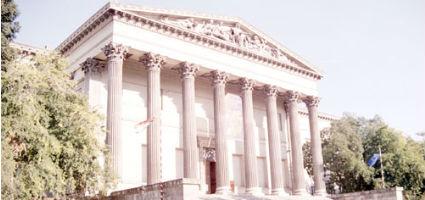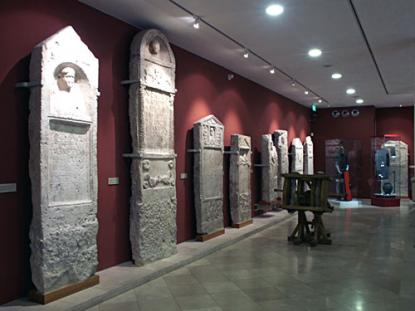2024. November 21. Thursday
Hungarian National Museum - Budapest
 |
Address: 1088, Budapest Múzeum körút 14-16.
Phone number: (1) 338-2122
E-mail: info@hnm.hu
Opening hours: Tue-Sun 10-18
|
Museum tickets, service costs:
|
Ticket for adults
|
1100 HUF
|
|
|
Ticket for students
|
550 HUF
|
|
|
Ticket for soldiers
|
550 HUF
|
|
|
Ticket for pensioners
|
550 HUF
|
|
|
Ticket for families
(2 adults + children)
|
1150 HUF
|
/ family
|
|
Individual guide
|
400 HUF
|
/ capita
|
|
Group guide
(max. 5 people)
|
1800 HUF
|
/ group
|
|
Group guide
(11-15 people)
|
6000 HUF
|
/ group
|
|
Group guide
(max. 15 people)
|
5500 HUF
|
/ group
|
|
Group guide
(16-25 people)
|
9700 HUF
|
/ group
|
|
Group guide
(1-5 people)
|
1500 HUF
|
/ capita
|
|
Group guide
(6-10 people)
|
13000 HUF
|
/ group
|
|
Group guide
(11-15 people)
|
16000 HUF
|
/ group
|
|
Group guide
(16-25 people)
|
24000 HUF
|
/ group
|
|
Group guide for students
(max. 25 people)
|
4500 HUF
|
/ group
|
|
Group guide for students
(max. 15 people)
|
6000 HUF
|
/ group
|
|
Group guide for students
(max. 25 people)
|
12000 HUF
|
/ group
|
The exhibition displays the most characteristic stone relics of the internationally acclaimed collection of the museum: niche, tombstones, sarcophaguses, pieces of little, temple shaped sepulchers, altars, and inscriptions of constructions.

The tradition of writing inscriptions, along with several other innovations of the period, came into the area of Pannonia with the Roman army and spread among the Celtic and Illyrian population. The tombstones for the soldiers and the population that settled around the camps were made in the stone-mason workshops of the army.
The stone relics improve our knowledge on the history of Pannonia and of the history of art at a period which is scarcely documented. The inscriptions tell us about the build up of the institutions and offices of both the Romans and the natives, they have data on the economic situation, the stations of the army, and the original birthplaces of the soldiers. We may also deduct information concerning the political events and that of the art of war.
The stone relics with no inscription imply the traditions of clothing, burials, and we may peek into the everyday lives of the Romans. The stones of Pannonia often picture scenes with carriages which, according to some researchers, can be explained with the belief of the natives that the dead are carried to the afterworld on a carriage.
Another characteristic of the stoneworks is that they often pictured Greco-Roman gods. This tradition was established by the stone-masons who arrived from Nuricum to Acquincum in the 2nd century. The mythological scenes which generally ornamented graves were taken from book of patterns used all over the Empire.
The votive memoirs portraying the God and his myth were erected in the shrines of the most popular gods of the natives of Pannonia.
The decimated population which turned poor following the attacks of the barbarians could not afford to erect stone monuments in the 3rd century AD. We know of more monuments mainly plain, spare of ornaments, from the 4th century. Many of the used sarcophaguses were reused again around this period. The tombstones of the ruinous villages and mansions were also reused at constructions.

The tradition of writing inscriptions, along with several other innovations of the period, came into the area of Pannonia with the Roman army and spread among the Celtic and Illyrian population. The tombstones for the soldiers and the population that settled around the camps were made in the stone-mason workshops of the army.
The stone relics improve our knowledge on the history of Pannonia and of the history of art at a period which is scarcely documented. The inscriptions tell us about the build up of the institutions and offices of both the Romans and the natives, they have data on the economic situation, the stations of the army, and the original birthplaces of the soldiers. We may also deduct information concerning the political events and that of the art of war.
The stone relics with no inscription imply the traditions of clothing, burials, and we may peek into the everyday lives of the Romans. The stones of Pannonia often picture scenes with carriages which, according to some researchers, can be explained with the belief of the natives that the dead are carried to the afterworld on a carriage.
Another characteristic of the stoneworks is that they often pictured Greco-Roman gods. This tradition was established by the stone-masons who arrived from Nuricum to Acquincum in the 2nd century. The mythological scenes which generally ornamented graves were taken from book of patterns used all over the Empire.
The votive memoirs portraying the God and his myth were erected in the shrines of the most popular gods of the natives of Pannonia.
The decimated population which turned poor following the attacks of the barbarians could not afford to erect stone monuments in the 3rd century AD. We know of more monuments mainly plain, spare of ornaments, from the 4th century. Many of the used sarcophaguses were reused again around this period. The tombstones of the ruinous villages and mansions were also reused at constructions.
